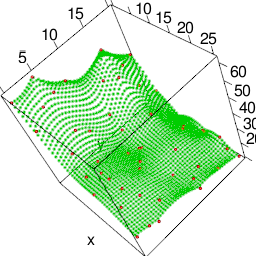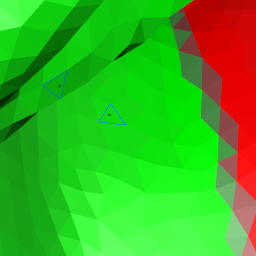markdown 形式のrmarkdown とknitr を使って、授業資料の作成および解析結果の報告、宿題の提出などやっている。
HTML にすることでrgl の3D プロットなども出せるので、3D データを扱っているときにもよさげ。
真面目にやるならpandoc をインストールしてrender して…というので初心者は挫折する可能性があるが、Rstudio ならばknitr ボタンをポチるだけでできる。
いくつかハマった箇所。
いい感じの見出しや目次をつけたいとき、一番上に書いておけばいい感じになる。
---
title: "Title"
author: "Author name"
date: "Any date such as created or presented date"
output:
html_document:
toc: true
toc_depth: 4
number_section: true
---
Created at `r Sys.time()`.
rmarkdownのchunk オプションをまとめて書いておけば一括で変更できる。
```{r echo=FALSE, warning=FALSE, message=FALSE, comment=""}
knitr::opts_chunk$set(echo=TRUE, eval=FALSE, warning=FALSE, message=FALSE, comment="")
```
本文自体はmarkdown 記法にしたがってかく。例えば見出しにリンク付きハイライトを書いたとしても、目次では目次番号がHTML 内リンク、見出し文字がリンク先へリンク、となっている。
rgl は少し挙動がオカシイときがある。こちらを参考にオプションをセットし
```{r setup, eval=TRUE, echo=FALSE}
library(rgl)
knitr::knit_hooks$set(rgl = hook_webgl)
```
実際にplot3d を出力する部分はrgl=TRUE を設定すればよい。
```{r rgl=TRUE, eval=TRUE}
plot3d()
```
しかし、ubuntu が悪いのかrgl するデータ容量が大きすぎるのが悪いのか、chrome が悪いのか、結構な頻度で
You must enable Javascript to view this page properly.
と言われてhtml 上、表示されないことがある。windows に持っていくと見れることもある。
というわけでサンプル。.Rmd として保存して、render するかRstudio でknitr ボタンをポチる。
---
title: "Matrix and Gram-Schmidt orthonormalization process"
author: "@Med_KU"
date: "20160705"
output:
html_document:
toc: true
toc_depth: 4
number_section: true
---
Created at `r Sys.time()`.
```{r echo=FALSE, warning=FALSE, message=FALSE, comment=""}
knitr::opts_chunk$set(echo=TRUE, eval=FALSE, warning=FALSE, message=FALSE, comment="")
```
```{r setup, eval=TRUE, echo=FALSE}
library(rgl)
knitr::knit_hooks$set(rgl = hook_webgl)
```
Vector is mathematically a set of [scalar](https://en.wikipedia.org/wiki/Scalar_(mathematics)). Vector has scalar values and direction.
R keeps data by *vector* structure. This is an essential form. This is defined by `c`.
The data made in R is called *object*.
```{r}
dat <- c(1, 2, 10, 5, 9, 291)
dat
```
You can access to i th element in the *vactor* by `dat[i]`.
```{r}
dat[4]
```
You can modify the *vector object* by adding or reducing its elemetns.
```{r}
c(dat, 4, 1, 5, 12312)
dat[-4]
```
You can sum/diff/multiply/divide the *vector* or each element between *vector*s.
```{r}
# define another vector
dat1 <- c(3, 13, 64, 11, 0, 4)
sum(dat)
dat[3] + dat[1]
dat + dat1
dat[1] - dat[2]
diff(dat)
dat - dat1
dat[1] * dat[5]
prod(dat)
dat * dat1
dat/dat1
```
*Matrix* is a 2 dimensional data structure. *Matrix* keeps data as N length vectors by M columns.
This is called N by M (dimension) *matrix*. *Matrix object* is defined by `matrix`.
```{r}
mat <- matrix(dat, nr=2, nc=3)
mat
```
We can access the cell (or element) in the matrix by indicating indices. If you want to take the cell of second row and third column, write `mat[2, 3]`.
```{r eval=TRUE, echo=FALSE}
hoge <- matrix(c("", "", "↓", "→", "→", "i, j"), nr=2, byrow=TRUE)
```
```{r eval=TRUE, echo=TRUE, comment=""}
hoge
```
**Warning!!** Elements in a matrix object should be the same class. In upper case, "", arrows, and 'i, j' are *character*. If there are various type of objects, object type will be forced to transform into *complex* > *character* > *float* > *integer* automatically. To avoid this problem, *data.frame* is sometime used.
Arithmetic operators for *matrix* are two ways. One is an operator for each element. Like arithmetic operators for *vector* in upper cases, simple description of `+`, `-`, `*`, and `/` return results of each element.
That is, there are two matrices $A=\begin{pmatrix}a_{1,1}&a_{1,2}\\a_{2,1}&a_{2,2}\end{pmatrix}$ and $B=\begin{pmatrix}b_{1,1}&b_{1,2}\\b_{2,1}&b_{2,2}\end{pmatrix}$, `+` operator returns $A+B=\begin{pmatrix}a_{1,1}+b_{1,1}&a_{1,2}+b_{1,2}\\a_{2,1}+b_{2,1}&a_{2,2}+b_{2,2}\end{pmatrix}$
```{r echo=FALSE}
mat1 <- matrix(1:4, nr=2)
mat2 <- matrix(5:8, nr=2)
```
```{r}
mat1 + mat2
mat1 * mat2
```
On the other hand, `%*%` operator returns matrix mutiplication $AB=\begin{pmatrix}a_{1,1}b_{1,1}+a_{1,2}b_{2,1}&a_{1,1}b_{1,2}+a_{1,2}b_{2,2}\\a_{2,1}b_{1,1}+a_{2,2}b_{2,1}&a_{2,1}b_{1,2}+a_{2,2}b_{2,2}\end{pmatrix}$.
**Optional**: `%*%` operator for *vector* returns inner product.
Gram-Schmidt process is a method to orthonormalize a set of vectors in an inner product space. We generally suppose 3 dimensional space ($\mathbb{R}^3$) but it can be generalized in $\mathbb{R}^n$ space.
You replace a set of basis $\boldsymbol{v}=\{v_1, v_2, v_3\}$ with another set of basis $\boldsymbol{u}=\{u_1, u_2, u_3\}$. During the process, *normalization* and *orthogonalization* can be done.
Given *vector*s $\boldsymbol{x}$ and $\boldsymbol{y}$, these processes are performed as below.
***normalization***: *Normarization* means set length of *vector* (*norm*) 1. Length is difined as $|\boldsymbol{x}|$. That is, *normalization* returns $\boldsymbol{x}=\cfrac{\boldsymbol{x}}{|\boldsymbol{a}|}$.
***orthogonalization***: *Orthoganal* means crossing two *vector*s by 90 degree. Angle between *vector*s $\boldsymbol{x}$ and $\boldsymbol{y}$ is difined as $\theta$, and $\theta$ can be also defined by *inner product*
$cos{\theta}=\cfrac{\boldsymbol{x}\cdot \boldsymbol{y}}{|\boldsymbol{x}||\boldsymbol{y}|}$.
When $\theta=\pi$, $cos{\theta}=0$. That is $\boldsymbol{x}\cdot \boldsymbol{y}=0$.
Let's take a *vector* $\boldsymbol{a}$. This *vector* has three *vector*s `a1 <- c(1, 1, 1)`, `a2 <- c(1, -1, 2)`, and `a3 <- c(-1, 1, 3)` in itself. Data structure looks like *matrix*.
```{r eval=TRUE}
a <- cbind(c(1, 1, 1), c(1, -1, 2), c(-1, 1, 3))
```
```{r eval=TRUE, out.width=480, out.height=480, fig.width=7, fig.height=7}
# install.packages("scatterplot3d")
s <- scatterplot3d::scatterplot3d(t(cbind(0, a)), pch=16, xlab="x", ylab="y", zlab="z")
dt <- seq(0, 1, length=100)
for(i in seq(ncol(a))){
s$points3d(t(outer(a[, i], dt)), cex=0.01, col=i+1)
}
```
```{r rgl=TRUE, eval=TRUE}
plot3d(t(cbind(0, a)), pch=16, xlab="x", ylab="y", zlab="z")
spheres3d(t(a), radius=0.05)
for(i in seq(ncol(a))){
lines3d(rbind(0, a[, i]), lwd=2, col=i+1)
}
```
From *vector*s $a$, you want to get Gram-Schmidt *vector*s $u$. Gram-Schmidt process is performed as below.
1. STEP 1: $u_{1}=\cfrac{a_{1}}{|a_{1}|}$
2. STEP 2: $b_{2}=a_{2}-(a_{2}\cdot u_{1})u_{1}$, then $u_{2}=\cfrac{b_{2}}{|b_{2}|}$
3. STEP 3: $b_{3}=a_{3}-(a_{3}\cdot u_{1})u_{1}-(a_{3}\cdot u_{2})u_{2}$, then $u_{3}=\cfrac{b_{3}}{|b_{3}|}$
$b$ is a temporal objects.
Gram-Schmidt process is much major and famous algorithm. Someone has already implemented in R as a function.
[pracma](https://cran.r-project.org/web/packages/pracma/index.html) package has a function `gramSchmidt` to perform it. A precise result is $u_{1}=\cfrac{1}{\sqrt{3}}(1, 1, 1)$, $u_{2}=\cfrac{1}{\sqrt{42}}(1, -5, 4)$, and $u_{3}=\cfrac{1}{\sqrt{14}}(-3, 1, 2)$.
```{r echo=TRUE, eval=TRUE}
# install.packages("pracma")
library(pracma)
(a_g <- pracma::gramSchmidt(a))
```
```{r rgl=TRUE, eval=TRUE}
plot3d(t(cbind(0, a)), pch=16, xlab="x", ylab="y", zlab="z")
spheres3d(t(a), radius=0.05)
for(i in seq(ncol(a))){
lines3d(rbind(0, a[, i]), lwd=2, col=i+1, lty=3)
}
spheres3d(t(a_g$Q), radius=0.05, col="yellow")
for(i in seq(ncol(a_g$Q))){
lines3d(rbind(0, a_g$Q[, i]), cex=0.01, lwd=4, col=i+1)
}
```
1. Define any *vector* as you like.
2. Calculate mean of that *vector* by writing down the difinition of mean and using pre-implemented function in R.
3. Define 3 by 3 *matrix* $M$ as you like.
4. Calculate *matrix multiplication* $M^3$.
5. Perform Gram-Schmidt process of $M$. As shown in above, you need 3 steps.
6. Check whether STEP 5 is performed successfully, that is, compute *inner product* of the basis of Gram-Schmidt $M$ and length of it (This procedure needs multiplication and summation. These functions are in R.).

を用いて
と書ける。
について、(i, i), (i, j), (j, i), (j, j) 成分をひらすら上の
で置換していけば、ある軸での回転を表す。
、y軸まわりに
、z軸まわりに
回転することを考えると、
を回転させて得られる座標
は


も行列だと思えば、例えばこれがxyz 座標に相当するとして、
と考えれば、


























